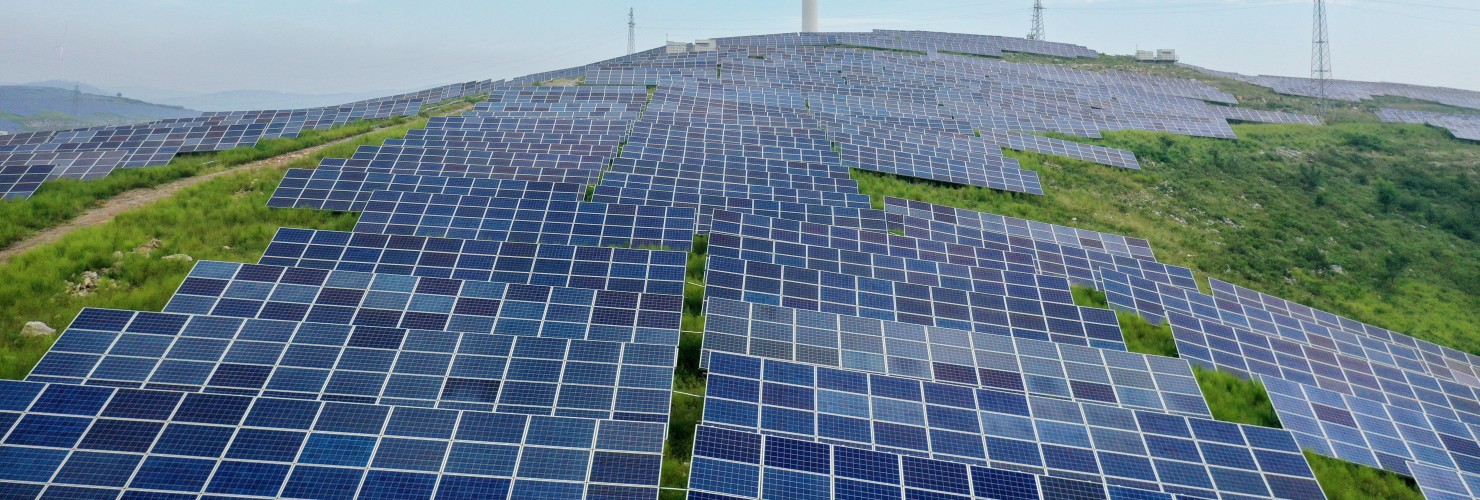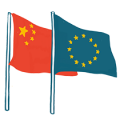

EU-China climate cooperation + China's new Special Representative for Central and Eastern Europe
ANALYSIS
Should the EU insist on a cooperation agenda with China? The case of climate change
When asked about the content of the cooperative aspect of the EU’s three-pronged approach to China, European officials generally share the same answer — climate change. The answer has become so prevalent that it is treated as self-explanatory common knowledge.
As the logic goes, with China’s late and rapid industrialization being a key factor of the current emissions problem and China being an essential part of the solution, cooperating with Beijing on climate is essential.
That is why many in the EU have hoped to compartmentalize the relationship and maintain climate cooperation even at a time when the remaining aspects of EU-China relations are fraught. But such an approach may be increasingly impossible to implement over Beijing’s unwillingness to shield the climate agenda from impact of geopolitical tensions. Insisting that we need to keep this political cooperation channel open to Beijing can even be potentially harmful to EU interests vis-à-vis China. The focus should be moved towards navigating the looming green competition and technical agreements.
Why we need China
China is the biggest CO2 polluter (around 30 percent of global emissions) but also the biggest investor in energy transition (USD 297.5 billion in 2021 compared to EU member states’ USD 155.7 billion and USD 119.7 billion). The EU also relies on China for imports or processing of materials critical to green technology — such as polysilicon used in solar panels, lithium used in advanced batteries or neodymium used in wind turbines.
The EU and China have achieved some success in climate engagement. For example in July last year China launched its national emissions trading system after nearly a decade of cooperation within EU-funded capacity building projects or in November 2021 at COP26 the EU and China reached a common ground taxonomy in relation to climate change mitigation. Some in Brussels have also regarded, somewhat wishfully, the EU’s own Green Deal announcement and Western pressure as an instigation for President Xi Jinping’s September 2021 pledge to reach carbon neutrality by 2060 and end financing for overseas coal projects.
Then there is also the EU-China High-level Environment and Climate Dialogue created during the September 2020 EU-China leaders meeting. The format has brought together European Commission Executive Vice President Frans Timmermans and PRC Vice Premier Han Zheng three times, however it has yet to produce major results and has been described by some EU officials as little more than an opportunity to present one another’s positions on their respective climate agendas.
For many keeping such windows of communication open, however imperfect, is still a beneficial way of attempting to put political pressure on China to develop a common agenda.
Politics strike back
Yet, recent events signal that Beijing is unwilling to shield the climate agenda from geopolitical turbulences or may even be open to leveraging it. A clear indication came with the response to Nancy’s Pelosi’s visit to Taiwan when Beijing suspended eight bilateral dialogues with the United States — including on climate.
Beijing sent discouraging signals also in bilateral relations with Brussels and within multilateral frameworks.
On September 7, at a public event focused on China-Europe cooperation on decarbonization, Wang Hongjian Charge d’affaires of Mission of the PRC to the EU stated that “green cooperation cannot be promoted in a vacuum”, highlighting that cooperation on climate is in Beijing’s view not compatible with geopolitical confrontation. Wang — sticking to the official line — also criticized the EU’s “protectionist measures” referring to the soon-to-be-introduced Carbon Border Adjustment Mechanism.
Also on the multilateral level, EU-China climate cooperation has faced setbacks as Beijing proves a wavering climate partner. During last week’s G20 climate talks, the participants did not manage to agree on a joint communique. In a thinly veiled allusion to China, Timmermans spoke of key players attempting to backtrack on commitments from Glasgow and “try and hide behind developing countries to use arguments that, I think, are no longer viable.” In response, Chinese Ministry of Foreign Affairs rebuked the accusation of abandoning Glasgow commitments and stated that “as a developing country, China has always stood by a large number of developing countries and firmly defends its common interests” at the G20 talks.
Competition and security
But political will aside, the space for cooperation may be further narrowing as the climate agenda is merging with economic competition. After all, European and Chinese actors will increasingly seek benefits for catalyzing the green transition.
What is more, the energy crisis brought about by the EU’s overdependence on Russian energy pushed the EU to approach its dependency with a more security-minded approach, which does not support a favorable framing of climate cooperation. Instead, it creates an additional impetus for re-evaluating dependencies on Chinese exports of goods crucial for a green transition such as solar panels or lithium batteries. In the words of EU Commission President Ursula von der Leyen on the reliance upon Chinese raw materials “we have to avoid falling into the same dependency as with oil and gas.”
And that dependence is going to become more politically thorny since approximately 95 percent of solar panels are likely to include material sourced from Xinjiang. That means that the new anti-forced labor mechanism (see below) is going to make the EU-China climate agenda even more fraught.
Way forward
Given the above, the EU should consider three issues:
First, whether it is productive to insist on climate change being an area of cooperation rather than to prioritize setting up a technical framework for constructive climate competition. That is not to say that Beijing should not be engaged with on climate issues. For instance, constructive competition requires jointly setting up green tech standards and there is also a lot the EU can learn from China’s own climate policies. However, the idea that the EU can affect Beijing’s stance on climate, based primarily on political good will, seems to be a foregone conclusion. Beijing is unlikely to abandon its climate agenda, especially given the increasing cases of domestic heatwaves and droughts, but will likely move at its own pace with limited interest in expectations of the developed countries.
Second, the EU should be clear-eyed about the overall decreasing number of major cooperation points on its agenda with China and reflect that in its diplomatic language. Especially since Beijing is unwilling to compartmentalize different aspects of relations with the EU. By staying openly and consistently committed to maintaining a cooperation agenda, Brussels may be giving Beijing an impression that such an offer is unconditional and that China can stabilize the relations with the EU at will with low-cost political gestures (as discussed here). Instead, a more pragmatic approach, where "cooperation-style" engagement, requiring tangible and verifiable commitments on both sides, could prove more productive.
Finally, the EU needs to be ready for the climate agenda to have an even greater geopolitical emphasis. As it is primarily developing countries that are most affected by the climate crisis and that are the key target of Beijing’s outreach, China may boost its climate-related offering via the Global Security Initiative and the Global Development Initiative. This would be simultaneously a very welcome development, but also a challenge that would require the EU to ensure its own support is at least equally meaningful and visible — for instance as part of the Global Gateway and ideally as part of constructive competition.
Read more:
PROFILE
Jiang Yu — China’s new Special Representative for Central and Eastern European Countries
In August, Ms. Jiang Yu (姜瑜) replaced Ms. Huo Yuzhen (霍玉珍), who since 2015 has served as China’s MFA Special Representative for Cooperation with Central and Eastern European (CEE) countries.
CEE trips
The change follows Ms. Huo’s unsuccessful trip to the region in April and May, when she tried to address and mitigate the tensions in the China-CEE cooperation framework, stemming from China’s tacit support for Russia’s invasion of Ukraine and from Beijing’s fallout with Vilnius. The departure of Latvia and Estonia from the China-CEE framework last month is likely to have prompted Beijing to make the final decision about the personnel change, allowing Huo to retire from her post.
Jiang is jumping straight into the deep end starting her mandate with a trip to the region. Between September 10 and 24 she will visit Czechia, Slovakia, Poland, Romania, Bulgaria, and Hungary. Like Huo’s trip, Jiang is accompanied by think tankers from the Chinese Academy of Social Sciences, who are also meeting with their local counterparts to get a sense of the situation on the ground.
Background comparison
Jiang, compared to Huo, is less of a regional expert. Most of Huo’s career has been focused on Czechoslovakia and, following the Velvet Divorce, the Czech Republic. In contrast, Jiang has “only” been involved with the region jumping from her position of Deputy Commissioner of the Office of the Commissioner of the Ministry of Foreign Affairs in Hong Kong to ambassadorial roles in Albania (2015-2018) and in Romania (2019-2022). She also is most likely not proficient in any of the regional languages in contrast to Huo’s proficiency in Czech but is supposedly a highly proficient English speaker.
Jiang has much more experience with the information department of the MFA and has served as China’s MFA spokesperson as well as having held a similar position in Hong Kong. Rather than being a regionally savvy diplomat, her background appears to reveal an astute political communicator, one who is adept at spinning the official line.
Curiously both Huo (2011-2015) and Jiang (2015-2019) served as ambassadors to Romania prior to taking on the mantel of regional envoy. Similarly, Xu Feihong (徐飞洪), who also headed the Romanian Embassy (2015-2018) was promoted to Vice-Minister position. This may be a coincidence, but the post in Romania may function as a springboard or testing ground for Chinese diplomats.
Takeaways
- The change indicates that Beijing is aware of the level of tensions with CEE states. It opted not to delay the personal reshuffle until after the Party Congress (as in the case of the China’s Ambassador to the EU).
- However, the choice of Jiang may signal that Beijing is less interested in reinvigorating the relationship by dispatching a diplomat with a long-built understanding of the region, but more interested in introducing a spokesperson capable of managing escalating political tensions and communicating the party line precisely.
- Jiang will receive a baptism of fire, as her trip coincides with the SCO meeting in Samarkand, where Xi Jinping and Vladimir Putin are expected to highlight their alignment — a thorny issue for CEE countries.
- The personnel change is unlikely to affect the positioning of CEE countries towards China. An open question remains whether Jiang has been sent with any proposals for remodeling the China-CEE cooperation format (as Huo, who during her trip floated the idea of reducing its level from the level of Prime Ministers to a Ministerial level).
Read more:
- MERICS: Can China win back Central and Eastern European states? (Huo Yuzhen’s trip)
- MERICS: How China lost Central and Eastern Europe
- MERICS: The crisis in the Taiwan Strait: the European front
SHORT TAKES
EU Commission releases proposal of anti-forced labor mechanism
The proposal unveiled on September 14 shows the EU’s commitment to its values and comes on the heels of the recently published UN report confirming “grave human rights violations in Xinjiang.” Once implemented it has the potential to disrupt operations of multiple European companies active in China.
- European Commission: Proposal for a regulation on prohibiting products made with forced labour on the Union market
China mentioned three times in von der Leyen’s state of the Union speech
Von der Leyen referred to the EU’s dependence on China in the context of critical raw materials and their processing (close to 90 percent of rare earths and 60 percent of lithium are processed in China) when announcing a European Critical Raw Materials Act. The Commission President also referenced China in the context of Defence of Democracy package linked to responding to foreign information manipulation and interference measures.
- European Commission: Commission President Ursula von der Leyen’s annual State of the European Union address
- SCMP: Europe ‘losing’ narrative battle to Russia-China anti-Western message
Xi-Putin meeting monitored closely in Europe
China’s President Xi Jinping and Russia’s President Vladimir Putin meet in Samarkand, Kazakhstan on September 15 on the sidelines of the Shanghai Cooperation Organization summit. This also marks the first international trip undertaken by China’s leader since the pandemic broke out. will set the tone for G20 summit this November. Keep an eye for our upcoming MERICS EU-China Opinion Pool, where we will ask selected experts what lessons the EU should draw from China’s position vis-à-vis Russia’s invasion of Ukraine, as the war approaches its seventh month.
- Reuters: Xi and Putin to meet in Silk Road city to discuss Ukraine, Taiwan
- Carnegie: The Wrong Way to View the Xi-Putin Meeting
- MERICS: China moves to fill the void left by Russian sanctions – on its own terms
Latest developments in EU-Taiwan relations
The decision announced on September 12 follows the establishment of the “Taiwanese Representative Office in Lithuania” in November last year, which prompted backlash from Beijing. Paulius Lukauskas will head the office. On the same day, Karolis Žemaitis, Lithuania’s Vice-Minister of Economy and Innovation led a 28-person strong delegation to Taiwan including representatives of high-tech sectors.
The European Parliament is planning to vote on a motion to adjust the name of the EU’s representative office in Taipei — currently called the “European Economic and Trade Office” — to reflect the broader nature of EU-Taiwan relations. Following a leak, José Casimiro Morgado, the Director of the European Union Intelligence and Situation Centre, the civilian intelligence agency within the European External Action Service, canceled an exchange with Taiwanese officials scheduled for October. It remains uncertain whether the leak was a result of human or digital security breaches.
- SCMP: Lithuania set to open Taiwan representative office and risk further anger from Beijing
- Focus Taiwan: Lithuania vice minister, tech business delegation begin official visit
- Focus Taiwan: Taiwanese, Lithuanian financial institutions sign loan guarantee accord
- European Parliament: Motion for a resolution on the situation in the Strait of Taiwan
- EEAS: Taiwan: Remarks by High Representative/Vice-President Josep Borrell at the EP debate on the recent developments
- Politico: EU intelligence chief cancels Taiwan trip after Beijing learns his secret plans

